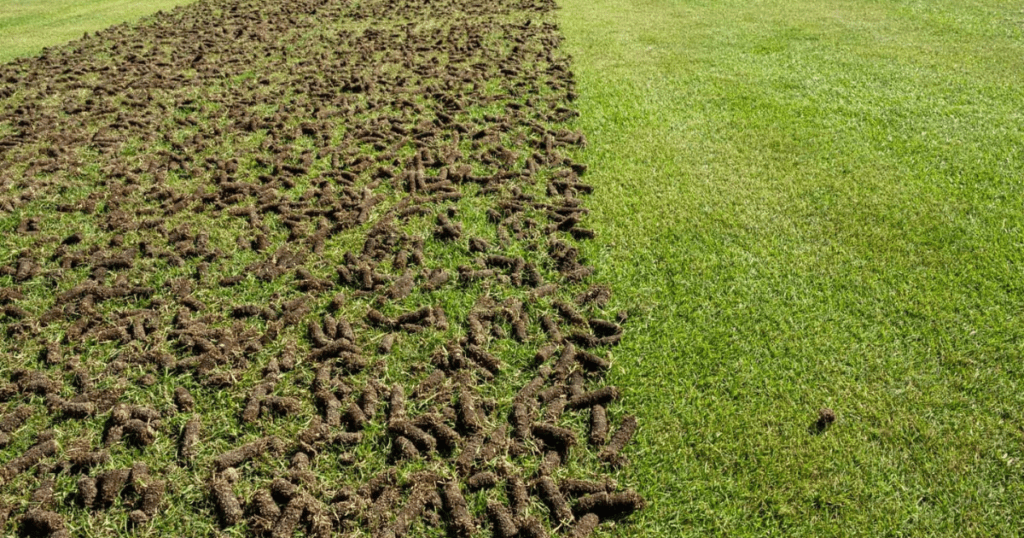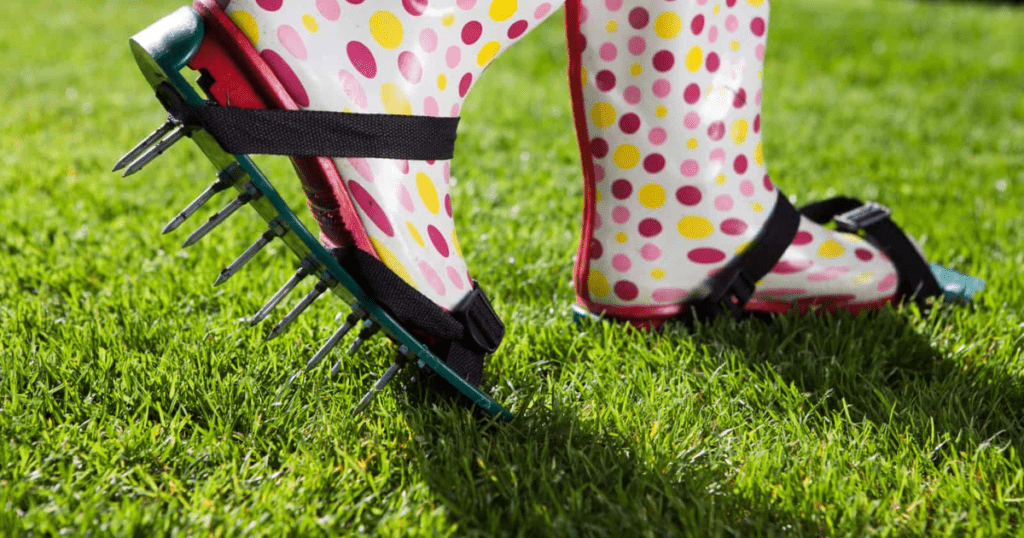You should remove the thatch layer from your grass after dethatching Lawn.
You have two options for dealing with thatch: compost or toss it away.
After dethatching, you should fertilize, overseed, and aerate your grass.
Now that you’ve dethatched your grass, you may wonder what to do next.
Initially, you must remove the thatch layer from your grass by composting or discarding it.
Afterward, you should give your grass other treatments, such as fertilizer, overseeding, and aeration.
Leaving Thatch Can Cause Issues
After dethatching, you still need to remove the thatch since, while largely composed of organic materials, it will not decay or break down naturally as grass clippings do.
If you leave thatch on top of your grass, it will mat back down to the soil’s surface and serve as a haven for insects, mildew, and illness.
Thus, it would be best if you got rid of it.
Remove The Thatch From Your Lawn
First, clear your lawn of thatch and dead grass by raking, bagging, and then disposing of or composting the waste.
Rake Your Lawn (Or Use A Leaf Blower/Vacuum)
After dethatching, you should rake up all thatch accumulation into heaps. It just takes a basic leaf rake to do the task.
You may also use a leaf blower to gather all the thatch into manageable heaps if you have a large yard or a lot of thatch.
Place The Thatch Into Bags

The next task is to gather all of those thatch mounds into trash bags, often known as grass and leaf bags. This may be completed by hand with the help of a leaf rake.
As a general guideline, you should use three trash bags or more for every 1,000 square feet of grass.
An alternative would be to use a leaf vacuum, but these devices often come with little bags, so if you have a large yard, you’ll need to replace many of them.
Option #1: Throwing The Thatch Away
You can dispose of your thatch if your local government provides a “green waste” alternative. This is a wise choice if you treat your grass with herbicides or insecticides in the months before dethatching. This is because adding chemicals to your compost is unsafe.
Remember that thatch left on your grass provides a habitat for insects and lawn diseases, so you should remove it immediately after dethatching.
Option #2: Composting The Thatch
Another option is to compost your thatch.Just be aware that thatch will take longer to decompose than other garden waste.
Getting rid of garbage in an eco-friendly manner is via composting grass thatch. Composting the thatch may enhance the quality of your soil and lessen the quantity of waste that ends up in landfills.
Composting grass thatch has many advantages. It first aids in lowering the quantity of garbage dumped in landfills. Second, converting organic waste into fertilizer rich in nutrients enhances the quality of your soil. Third, gardens and landscaping applications may benefit from the beneficial nutrients that composted grass thatch offers.
Sort the thatch on your grass into big and little bits first.In a compost pile, smaller pieces break down more quickly, while larger ones take longer to break down and require crushing before adding them to the mixture.
Add wet organic materials (leaves, yard clippings, garden residue, etc.) to your heaps every two weeks. Ensure the mixture is damp but not soggy—too much moisture will hinder the breakdown process.
Note: Since salt and other chemical fertilizers may damage the soil’s helpful microbes, wait to apply them until you’ve completed composting your lawn thatch.
Aerate The Lawn
It is advisable to aerate your grass after removing any loose thatch.The technique known as lawn aeration involves introducing air to the soil to increase water and oxygen availability.This promotes plant development, improving your grass’s health and aesthetics.
You should aerate your lawn regularly since it will help avoid brown spots, inhibit weed development, and improve water absorption.
Overseed The Lawn

Planting grass seed into an established lawn to increase its thickness, enhance its color, and suppress weed growth is called overseeding. Overseeding may give your grass a fresher appearance without requiring a complete makeover, but it also offers many additional advantages.
Overseeding the lawn may help keep weeds under control, provide the grasses more nutrition, and improve soil moisture levels. For your grass roots to withstand the strains of dethatching, you are also assisting your grass blades in developing robust sources.
Thus, treat your grass with something like Scott’s Turf Builder after dethatching and aerating.
Fertilize The Lawn
It is now time to fertilize your grass once you have finished overseeding. We advise applying some Milorganite to it, as it will aid in the recovery of your grass and provide much-needed nutrients.
In addition, fertilizer aids in weed control, plant development, and maintaining a healthy lawn.
Topdress The Lawn
Finally, you may topdress your grass if you’re feeling very ambitious. To improve your lawn’s soil, topdressing is applying a thin layer—roughly ¼ inch thick—of organic material, such as compost.
When we apply topdressing, we aim to provide the grass with nutrients that will gradually seep into the soil, fostering the best possible development for the turf.
In addition to strengthening the root system, topdressing helps suppress weeds by filling spaces before they can take root.
Common Mistakes To Avoid
Setting Blade Depth Too Deep Or Too Shallow
When dethatching their lawns, one of the most frequent errors homeowners make is setting the blade depth too deep or too shallow.If you set the blade depth too shallow, you may not remove thatch as efficiently, whereas setting it too deep might harm the grassroots. To ensure that the blade depth is appropriate for your particular kind of grass, it’s essential to strike the ideal balance and adhere to the manufacturer’s instructions or expert guidance.
Not Adjusting The Tool Direction Correctly
Another frequent error is making the incorrect tool direction adjustment during the dethatching operation. The amount of thatch accumulation in different parts of your lawn may vary. Therefore, modifying the rake or dethatching machine’s direction is critical to cover the whole grass equally. This avoids uneven thatch removal and guarantees all areas get the required dethatching treatment.
Incorrectly Estimating The Amount Of Thatch
Inaccurately estimating the quantity of thatch accumulation might result in excessive or inefficient dethatching. It is crucial to precisely determine the amount of thatch on your grass before beginning the dethatching procedure. Cutting off a little portion of your grass and measuring the thatch layer is an easy way to conduct a test. This will assist you in figuring out how much thatch has to be removed and if dethatching is essential.
As they can provide knowledgeable counsel and direction, lawn care professionals are the ideal people to approach if you need clarification about the quantity of thatch or the dethatching procedure.
Over-Dethatching The Lawn During The Process
Mistakes like over-dethatching the lawn are frequent and may seriously harm your grass. It’s crucial to remove the thatch layer around one-third at a time. Overdoing the thatch removal may weaken the grass, expose the soil to too much sunshine, and increase its susceptibility to disease and stressEncouraging a healthy lawn involves gradually dethatching, allowing the grass to recover and rejuvenate properly.
FAQ
Is it possible to aerate and dethatch simultaneously?
Performing dethatching and aerating separately is generally recommended. Aeration relieves compacted soil and improves air circulation to the roots, while dethatching removes the thatch covering.Separating these chores into manageable chunks will help you concentrate on each one more skillfully and provide the best possible outcome for your grass.
Is Overseeding Still Possible After Dethatching?
Of course! In fact, after dethatching your grass, overseeding is strongly advised. The grass seeds have the best chance of taking root in the soil during the dethatching process. The dethatcher’s holes and gaps provide the sources direct access to the ground, improving germination and encouraging effective establishment. After dethatching, overseeding ensures a lush and colorful lawn by filling up thin or barren spots with fresh, healthy grass.
Can I Dethatch Using A Regular Rake?
A dethatching machine or specialized thatch rake is more efficient and less labor-intensive to use while dethatching a lawn than a standard rake. A standard rake can assist you in removing part of the thatch, but it may not be able to get rid of all the collected material because of its limited depth. On the other hand, a thatch rake or dethatching equipment has specifically made tines that can efficiently lift and remove the thatch without causing any harm to the grass.
Standard rakes work better for routine lawn upkeep duties like mulching and leaf raking. One solution is to reduce the amount of thatch on your little lawn by sometimes using a standard rake.For the best results, it is advisable to purchase a thatch rake or a dethatching machine for larger yards or lawns with substantial thatch buildup.
Does Dethatching Damage My Lawn?
When dethatching is done properly, it may improve ventilation, nutrient absorption, and the general health of the grass on your lawn. However, you must be cautious while dethatching to avoid harming your grass.
Too deep or too shallow of a blade depth setting is one typical error to avoid. If the blade depth is too shallow, the thatch may not be removed, while putting it too deep will harm the grassroots. To guarantee that the blade depth is appropriate for your particular variety of grass, it’s essential to adhere to the manufacturer’s instructions or consult a specialist.
One further thing to be careful of is over-dethatching the grass. The grass may become weaker and more vulnerable to stress and illness if too much thatch is removed. Removing more than one-third of the thatch layer at once is not advised.
Is It Possible to Dethatch My Wet Lawn?
Although dethatching your grass when wet is typically not advised, there are several circumstances in which it could be necessary. Wet grass may be more difficult to dethatch since the moisture can make it harder for a rake or dethatching equipment to remove the thatch.
One of the biggest worries when dethatching a wet lawn is that the rake tines or heavy machinery may crush the damp soil, harming the grassroots. Furthermore, moist thatch tends to clump together, making removal more difficult. To get the greatest results and reduce the chance of damaging your lawn, it is recommended to wait until the grass has dried completely before dethatching.
Check Also:
